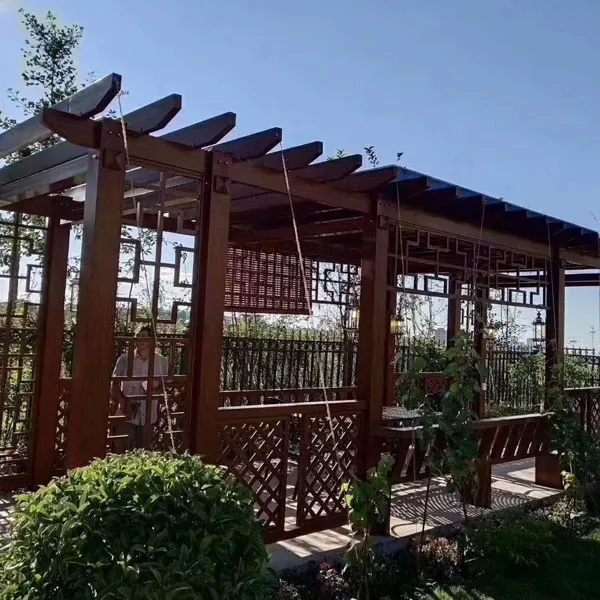What is the best material for a gazebo?
2024-09-23
Choosing the best material for a gazebo depends on factors like durability, aesthetics, maintenance, climate, and budget. Here are the most popular materials used for gazebos and their advantages:
1. Wood
- Best For: Aesthetic appeal and traditional designs.
- Popular Types: Cedar, redwood, pine, and teak.
- Pros:
- Natural, classic look that blends well with outdoor environments.
- Can be stained or painted to suit any design preference.
- Strong and durable, especially cedar and teak, which resist rot and insect damage.
- Cons:
- Requires regular maintenance, such as sealing, staining, or painting, to prevent weather damage.
- More expensive than some other materials, especially high-quality woods like teak or redwood.

2. Metal
- Best For: Modern designs and low-maintenance needs.
- Popular Types: Aluminum, steel, wrought iron.
- Pros:
- Highly durable and long-lasting, especially in harsh weather conditions.
- Aluminum is rust-resistant and lightweight, making it easy to move and maintain.
- Steel, when powder-coated, is highly durable and resistant to corrosion.
- Wrought iron offers a classic, elegant look with high strength.
- Cons:
- Steel and iron can be heavy and more difficult to install.
- Metal gazebos can get very hot in direct sunlight unless shaded or insulated.
3. Vinyl
- Best For: Low-maintenance and affordability.
- Pros:
- Resistant to moisture, rot, and insects, making it ideal for wet climates.
- Requires minimal upkeep—just occasional cleaning.
- Affordable compared to wood and metal options.
- Does not fade or crack easily when exposed to sunlight.
- Cons:
- Limited design options and less natural appearance compared to wood.
- Can be prone to cracking or becoming brittle in very cold weather.
4. Fiberglass
- Best For: Lightweight and durable structures.
- Pros:
- Lightweight yet strong, making it easy to install and move.
- Resistant to weather, rust, and corrosion.
- Can be molded into various shapes, allowing for unique design flexibility.
- Low maintenance and can be painted to mimic wood or other materials.
- Cons:
- Typically more expensive than vinyl and some metals.
- Limited availability compared to more traditional materials like wood or metal.
5. Polycarbonate (for Roofing)
- Best For: Gazebo roofs needing UV protection.
- Pros:
- Excellent for roofing, as it allows natural light while blocking harmful UV rays.
- Highly durable, resistant to cracking, and able to withstand extreme temperatures.
- Lightweight and easy to install.
- Cons:
- Used primarily for roofing rather than the main structure.
- Can be more expensive than traditional roofing materials like shingles.
Conclusion
The best material for your gazebo depends on your personal preferences and the specific conditions of your location. For a traditional, natural look, wood (especially cedar or teak) is ideal but requires more maintenance. For modern, low-maintenance options, vinyl and aluminum are excellent choices, while steel offers maximum durability. If you’re looking for something lightweight and durable, fiberglass may suit your needs. Each material has its pros and cons, so balancing factors like aesthetics, climate resistance, and upkeep will guide your decision.
YHJY Building Materials, based in China, is a professional Gazebo manufacturer and supplier of customized building materials.For inquiries, you can reach us at yuhoujiaoyang01@gmail.com.




















































